Articles of 2005
Andre Rozier Is Wreaking Havoc
Last Friday night the unthinkable happened to one of Andre Rozier’s protégés. Super middleweight Jaidon Codrington, the brightest prospect in New York, was knocked out in 18 seconds by Allan Green. It was supposed to be his unveiling before a national audience on ShoBox, but instead the 9-0 boxer-slugger found himself unconscious for roughly three minutes.
As awful as the knockout was, the pandemonium that followed as the fighter lay on his back, helpless to the world, was worse. Besides the fact he could have been trampled by those storming the ring, the emotional overload from his people was hard to watch—and impossible not to. It was a display of love, grief, shock, fright, anguish, and more love. Members of Codrington’s family and camp lay next to him on the canvas trying to coax him back to consciousness with sympathetic words and sobs. “I love you, J! I love you, J! I love you, J!”
But a fighter is a solitary figure, ultimately facing his trials alone.
The unthinkable happens frequently in boxing. This was the underlying message of Andre Rozier’s discussion over dinner recently in downtown Manhattan. Rozier is Codrington’s co-trainer at the Starrett City Boxing Club in Brooklyn. He is also the head trainer of Jaidon’s still-undefeated stablemates, Joe Greene (6-0) and Curtis Stevens (9-0), and trains several blue-chip amateurs. The 41-year-old is a daily presence in their lives, a combination of a drill sergeant and a tough love parent.
“When we’re preparing for combat, it’s business time,” Rozier said, ordering a soy-based vegetarian dish and not the bloody steak one might expect. “I don’t want any joking, I don’t want any downtime, I don’t want any playing.”
The grave attitude Rozier instills in his fighters is his attempt to ensure the unthinkable won’t happen. Usually it doesn’t.
“We utilize aggressive techniques to win our battles. We commit to lots of attacks, we keep our number of punches up—combinations win fights. And you must always be tenacious. Always.”
Contrary to the trainer’s teachings, Codrington allowed Green to lock him in his corner and force the 21-year-old into a defensive role. That wasn’t Starrett City boxing, and Rozier couldn’t have liked what he saw.
For those of us who have only known fighters charging out of Rozier’s corner and doing the bullying, it was disconcerting. One can only imagine how Codrington felt, being the real green man, facing an equally skilled opponent but with nearly twice as many bouts (now 18-0, 12 KOs).
Rozier came to my attention in the late ‘90s, from following the local amateur boxing scene. If you heard a kid from “Coney Island Strong Brothers” might be fighting, you took on the motto of the United States Postal Service. (Neither snow, nor rain, nor heat, nor gloom of night stopped me from getting lost in far-flung neighborhoods that made Beirut look quaint.) A trio of “Strong Brothers”—lightweight Charles Vanderveer, middleweight Joe Greene, and light heavyweight Curtis Stevens—began their tutelage under Rozier not long after getting toilet-trained, and by the time they were 18 had an estimated combined record of 450- 20 (with a ton knockouts).
When these fighters began turning pro, Rozier moved camp from Coney Island to the East New York section of Brooklyn, where Starrett City is located. The gym, teeming with talent, is becoming a modern day version of Detroit’s Kronk, the boxing factory that during its golden age in the ‘70s and ‘80s cranked out champions like a Ford assembly line.
Of course, Codrington’s horrible crash will reverberate throughout Starrett City. This low-slung cinderblock dungeon buried beneath a garage has only known success lately. Along with Rozier’s aforementioned young roughnecks, WBA welterweight titlist Luis Collazo (26-1), junior welterweight Dmitriy Salita (23-0), featherweight Gary Stark Jr. (12-0), and elite amateurs William Rosinsky, Daniel Jacobs, Anthony Irons, and Saddam Ali all ply their trade there. If the fallen star doesn’t recapture his past glory, the fertile sweat-pit has capable understudies ready to fill in.
Everyone who enters this gym is on speaking terms with adversity, however. They all come from the roughest parts of Brooklyn and Queens, and were drawn to the hardest game for a reason. Rozier is no exception.
“You learn how to fight or you learn how to run,” Rozier chuckled, speaking of growing up in Brownsville, where his dynamo nephew Curtis Stevens still lives. Stevens dons a “B-Ville” bandana when he enters the ring, and it’s not simply local pride that elicits cheers from his neighborhood fans, but an acknowledgement that here is a clean living, driven, disciplined brother—something rarely broadcasted about his demographic.
Rozier once thought he was destined for fistic stardom, too. Before he was old enough to compete in the Golden Gloves, he had compiled a record of 52-2. He was a light heavyweight, about the same size he is now. His two losses only came when he was drained from dropping down to middleweight. When he was of age for the Gloves and took the physical, he failed—high blood pressure. He took the physical a week later, and failed again.
“I thought I was going to be world champion. I thought I was one of the few who had what it took. Unfortunately, it didn’t work out that way.”
Rozier examined the steaming dish placed before him, described as Creole chicken, but is actually a tofu creation flavored to taste like the real thing. He thinks that his high blood pressure was due to stress, but still decided to become a vegetarian. The vegetarian restaurant he chose, Red Bamboo, is one of his favorite places to unwind after doing 24 straight rounds of grueling pad work for his charges.
He left boxing for three years after failing his medical. But a kid who lived in his building wanted to learn how to box, and Andre started taking him to the gym. Since then, over 20 years later, Rozier hasn’t been able to resist the smell of liniment and sweat, the sound of leather on bone.
“I’m a teacher, and I like to guide my students. I was slated to be a trainer.”
Boxing has been his one true love, an obsession that never abates.
“My passion for the sport is so, so great. I remember when Ali was boxing on TV, I used to sneak around, grab a glimpse, because it was past my bedtime. But I’d peak around the corner and watch Ali. And I’d always say, ‘I wish I could be like that. I want to be like Muhammad Ali.’”
A roll call of his other favorite fighters includes Joe Frazier, Marvin Hagler, Sugar Ray Leonard, Azumah Nelson, Aaron Pryor. “The list goes on and on,” he said. “I watch every boxing match I can see. If there was 24 hours of boxing on TV, I’d be watching it.”
His fighters don’t share his lust for the sport, Andre said. They’ll catch the big fights, but would rather be doing the fighting themselves. Rozier understands that not everyone can be like him. He’s like that PhD candidate who never intends on getting his degree because it’s the learning that makes him tick.
His dedication to boxing notwithstanding, Rozier has other sides to him that cause you to do a double take.
“I’ve been sewing since I was 12 years old,” he said.
When he was growing up, custom tailors displayed their wares in front of their stores. It was an urban phenomenon, he explained, mainly catering to black and Hispanic youth.
“I wanted some of that special gear, I wanted tailor-made clothing. They had elaborate pants with zipper pockets, sharp materials like Aberdeen wool, stuff like that. It was really cool. But it was very expensive. Back then, tailor-made slacks were $50.”
Rozier said his family was middle class—albeit by Brownsville standards—and never wanted for anything. But the idea of mom parting with $50 so the 6th grader could have special pants was not happening.
If Rozier were to look like he just walked off the set of “Superfly,” his duds would have to be literally homespun. He asked his grandmother, an accomplished seamstress, if she would serve as his tailor. She declined but offered to teach him how to sew.
“She showed me how to cut, how to stitch, how to put fabric together, how to make sure your clothing was going together piece by piece,” he said. “I can still remember the first pair of pants I made. Oh my God, how grotesque they were! But, I made them.”
Nine months later he was putting money in his pocket, doing jobs for the tailors whose designs he used to ogle.
“By the time I entered high school,” he said, “I was the best dressed cat around. Every night I would make something. I would go to the material store; I’d have pants the next day. I had fifty pairs of pants in my closet. I was a fly guy, low-key and smooth. But the clothing does help. It gave me more savoir fair.”
A pragmatist, Rozier eventually married his two main pastimes, boxing and fashion. Thus was born his boxing apparel company Havoc Enterprises. When he isn’t instructing fighters at Starrett City, he’s likely at the New Jersey headquarters of Havoc. All of his fighters are outfitted in his glitzy designs, as well as some of the biggest names in the industry. When Diego Corrales entered the ring for his ballyhooed rematch against Jose Luis Castillo, he was resplendent in Havoc gear, which included a black cape that would be the envy of Batman. Fighters are increasingly wearing Havoc over the more established brands like Everlast, Grant, and Spartan.
The trajectories of his fighters’ careers and his apparel company have been skyrocketing in tandem.
“Everything is coming together,” said Rozier, who wore humble baggy sweats at dinner, reminding me of a gifted boxer who will throw easy combinations at half-speed when shadowboxing—they’ve got nothing to prove. The only item that stuck out was a “Mean Joe Greene” T-shirt of his own making.
Complimenting the clever advertising campaign on his chest, I shifted the conversation back to his litter pit-bull fighters, and Codrington’s upcoming fight. Rozier said that while he’s taught them to hunt down opponents with brutal efficiency, he always prays that no one involved gets seriously hurt.
It was implied when he said, “No one involved,” that he was referring not to his fighter but the other guy. At the time, it was almost unthinkable that on November 5th, Jaidon Codrington, the brightest prospect in New York, would need our prayers.
-
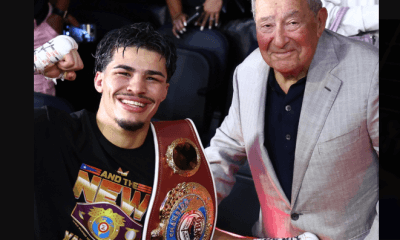
 Featured Articles2 weeks ago
Featured Articles2 weeks agoThe Hauser Report: Zayas-Garcia, Pacquiao, Usyk, and the NYSAC
-
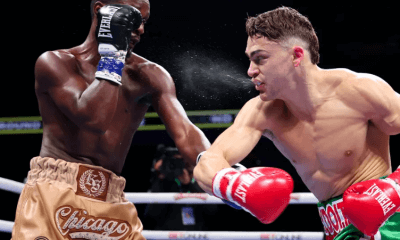
 Featured Articles1 week ago
Featured Articles1 week agoOscar Duarte and Regis Prograis Prevail on an Action-Packed Fight Card in Chicago
-
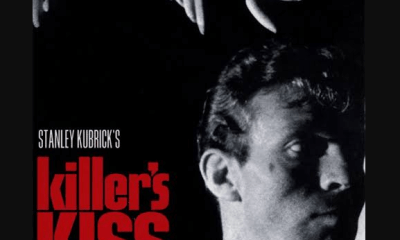
 Featured Articles6 days ago
Featured Articles6 days agoThe Hauser Report: Cinematic and Literary Notes
-
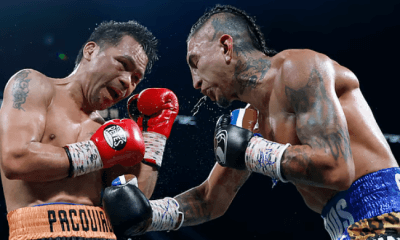
 Featured Articles3 weeks ago
Featured Articles3 weeks agoManny Pacquiao and Mario Barrios Fight to a Draw; Fundora stops Tim Tszyu
-
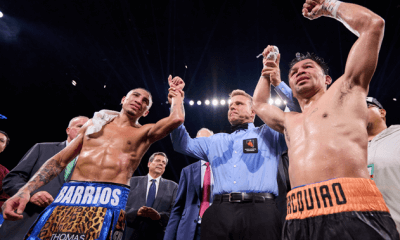
 Featured Articles3 weeks ago
Featured Articles3 weeks agoArne’s Almanac: Pacquiao-Barrios Redux
-

 Featured Articles2 weeks ago
Featured Articles2 weeks agoRemembering Dwight Muhammad Qawi (1953-2025) and his Triumphant Return to Prison
-
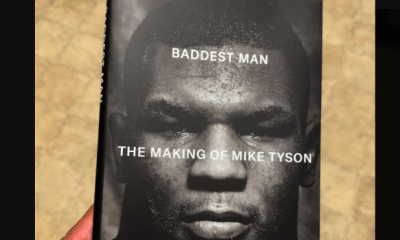
 Book Review1 day ago
Book Review1 day agoMark Kriegel’s New Book About Mike Tyson is a Must-Read
-
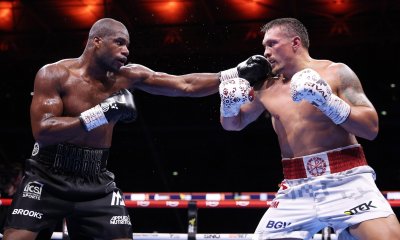
 Featured Articles3 weeks ago
Featured Articles3 weeks agoOleksandr Usyk Continues to Amaze; KOs Daniel Dubois in 5 One-Sided Rounds













